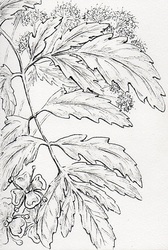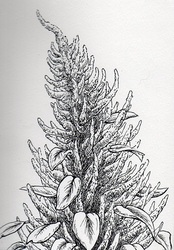Sign In
CloseToday's featured plant is the Kava-Kava. Also known as Asava Pepper, Kava, or 'Awa in Hawaiian, this shrub-like plant belongs to the pepper family. This plant grows to approximately 6 ft tall and as wide as around 10 inches with large, heart-shaped leaves. The Kava-kava can be found growing primarily on the maintains of Pohnpei, but it can be found throughout many of the Pacific Ocean islands. The Republic of Vanautu is accepted as the 'home' of the Kava plant due to its large population of cultivars, or areas of selective breeding for plants, but the specific origin of Kava-Kava is still a mystery. For growth, the Kava prefers damp and shaded areas to flourish, however, it actually produces very few, rare female flowers and can only grow through human pollination. It has been grown throughout multiple areas such as Vanuatu, Fiji, the Pacific Islands of Hawaii, and more. Multiple varieties of the Kava plant have been identified in these areas. Vanuatu has identified over 72 varieties while the Marquesas Islands have reported around 21 types. For hundreds of years, the Kava-kava plant has been cultivated and used by Pacific Islanders for a wide range of reasons such as treating fungal infections, headaches, asthma, worms, and more. The root of the Kava-kava plant can grow up to 2 feet in depth and possess kavalactones, or kava-pyrones, which have been proven in traditional and medical methods to be beneficial in muscle relaxation, anti-anxiety aids, and more. Uniquely, this plant's anti-anxiety properties do not effect alertness or reaction time when properly used. It is being studied on whether or not this plant is reacting with the limbic system directly. Kava is not generally harvested until after 4 years of age as the older the plant grows the stronger it's levels of kavalactones. Pacific Islanders would consume a drink created by grinding, grating, or pounding the roots before soaking the pulp in either water or coconut milk. This mixture was drank at ceremonies such as births, marriages, meeting village elders, welcoming honored guests, or as an offering to the gods. On Pohnpei, a rare and prized strand of Kava-kava called the Sakau is used to stop bleeding. It is so prized that it is seen as the only thing that can stop the anger of a king. If offered Sakau, one is required to accept and calm down. While the root of Kava plants have been used for ceremonial uses and healing abilities for thousands of years due to it's antiseptic, antispasmodic, and anti-inflammatory properties, it is important to know that only the root is used for these. The top of the Kava plant is known to be toxic to the liver and caused damage such as cirrhosis and liver failure. It is important to do research and consult a doctor before engaging in consumption of herbs. On a metaphysical level, the Kava-Kava plant is associated with feminine and water aspects .It is thought to aid in protection, strengthened visions, and positive luck. It is connected to three of the major Hawaiian Gods Lono, Kanaloa, and Kane.
Submission Information
- Views:
- 521
- Comments:
- 0
- Favorites:
- 0
- Rating:
- General
- Category:
- Visual / Traditional




